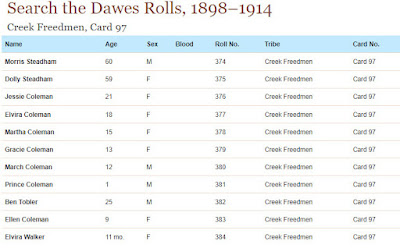Dolly Bruner Tobler Stidham (1830- 1926)
From the Gateway to Oklahoma History
She is thought to be the daughter of Mary Ann Grayson and Jake Bruner. She lived with this couple in Coon Creek near North Fork Town, Indian Territory, now under Lake Eufaula. When her son Robert Tobler married in 1893 he listed his mother as Dollie Bruner.
She spent most of her life north of Okmulgee,
which is south of Tulsa and once the Muscogee Nation.
Albert Pike (1809 – 1891)
After the Confederate government appointed Albert Pike as Confederate Commissioner of Indian Affairs he negotiated alliances with various Oklahoma tribes but resistant groups favoring the Union or neutrality gathered under Creek leader Opothleyahola. Confederates pursued the rebellious Indians who sought refuge in Union Kansas.
Opothleyahola (1778-1863)
Stand Watie (typo above) (1806-1871) a Cherokee
was a Confederate General
Dolly is listed as a "Freedwoman" in the early-20th-century photo's caption because that was her official classification in Creek records. Once freed she remained with the Watt Grayson family. During the war and the post war years she gave birth to ten children, perhaps, with the older seven being the children of James "JimBoy" Tobler. She had three with a man named Morris Coleman or Morris Stidham.
Was Dolly living at the Grayson home when he was robbed in 1873?
At some point she kept a boarding house.
The war-torn territory continued to be a place of almost incredible violence if we can judge by Dolly's family history. Of those ten children nine died deaths related to gun brutality. Four of her boys were said to have been hung for murder; a daughter and four boys were shot (one by his wife.)
1890, Leavenworth Times
Shifting population as outsiders moved into the post-war territory contributed to the chaos.
From Grinde & Taylor, Red Vs Black:
Conflict & Accommodation in the Post Civil War Indian Territory
Tribal settlers and the "Freedpeople" were allotted land. Through allotments, inheritance and litigation Dolly seems to have owned quite a bit of land.
Applying for allotments in Muscogee
Dawes Rolls card of Dolly's family. If she was 59 this would have been about 1889. Son March is listed as 12---he was born in 1887 so 1899 is more likely and Dolly and Morris's ages are wrong.
We interpret this woman, perhaps seated in her farm yard, according to our
own perceptions and prejudgements. She looks poor in our eyes, but
she was said to have been wealthy, living alone in a comfortable home.
1922 Okmulgee Times
She testified at several trials.
1922, Muskogee Democrat
A woman with some power in her community.
How she dealt with the violence and loss she lived with is harder to understand.
Her house collapsed; she lingered for a few weeks.
It would seem that only a tornado could vanquish her.
Her quilt top seems to have looked like this EQ8 sketch. The block has been published many times
but in Dolly's time the Clara Stone catalog of newspaper patterns called it Fish or Whirligig.
The WPA interviews of former slaves in the 1930s include Mary Grayson's who describes Indian Territory life. Dolly was probably a relative.

























7 comments:
I worked as a portrait photographer, and I think it's possible both the chair and quilt top came with the photographer. I bought lengths of fabric to use as backgrounds and drapes. I used a variety of props, a tiny wicker chair, a plaster column, a large wooden train set, etc.
In this time period the photographer's equipment would have required some kind of vehicle to transport.
A lot of good information about the Indian Territory that I didn't know.
Excellent post about this amazing woman.
A wonderful photograph of Dolly Stidham seated and wrapped up in a quilt top! I am inclined to believe that she is the proud owner/maker of the quilt top and I note that it has the triple strip sashing with 9 patch cornerstones seen on other late 19th c./early 20th Southern quilts. Thank you, Barbara, for such an interesting post.
What a strong and amazing woman.
Pat. I had to cut something and it was info about the photographer who was an Okmulgee librarian who took many pictures of her neighbors. Not the usual itinerant
Loved this story. It is very sad about her children. Back then I think people ate less, because there was less, helping them live longer. When looking at the depression it was the same. I sure respect this lady. Thank you.
Post a Comment